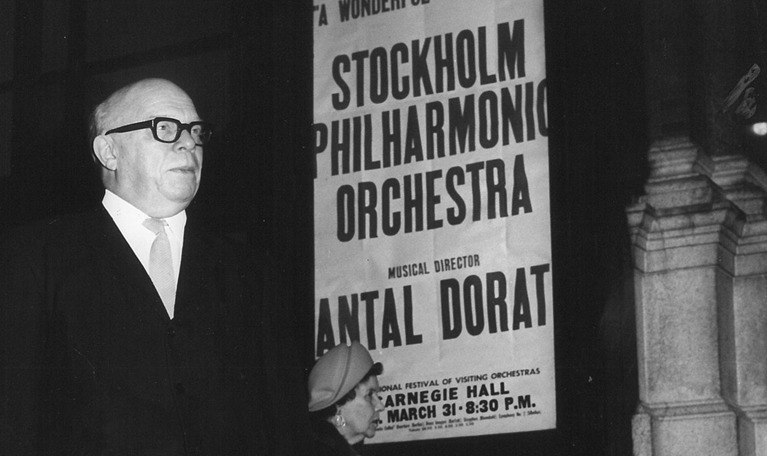Johannes Norrby

Johannes Norrby outside Carnegie Hall in New York in 1968.
Johannes Norrby served as executive director of Konserthuset from 1939–70.
In June 1939, Johannes Norrby became managing director and thus began a new era. Without competition, Norrby is Konserthuset’s longest-serving executive director of all time: he held the position until 1970! He was only the orchestra’s director at first, but from 1950, he became Konserthuset’s director as well, and thus the executive director (the title which is used today).
Johannes Norrby was 35 years old when he came to the orchestra, where his brother Gunnar was already a member of the cello section. As a ten-year-old, Johannes Norrby had heard the still-young orchestra play in Auditorium, and he regularly attended school concerts (of which he would later become a popular leader) and ordinary concerts alike.
He played the violin, viola and double bass, and in 1931 he was one of the founders of the Stockholm Chamber Orchestra. He also founded the vocal ensemble Voces Intimae and sang bass in the Björlingkvartetten (Björling Quartet). In 1934, he was appointed conductor of the Akademiska Kören (Academic Choir).
The highly versatile Johannes Norrby was important to Konserthuset in numerous areas. As its director, he helped the orchestra grow from an ensemble of 70 part-time musicians to 90 full-time musicians in the late 1960s. At that time, more specifically in 1957, the orchestra had also changed its name from Stockholm Concert Society to the Stockholm Philharmonic Orchestra (today’s name, the Royal Stockholm Philharmonic Orchestra, came into use in 1992).
But times were turbulent for Johannes Norrby when he came to Konserthuset. Due to the outbreak of World War II, he was forced to reorganise much of the 1939–40 season. Issues with musicians who had already been hired arose at once, and guest performances from the likes of Václav Talich, Bruno Walter and many more had to be cancelled. On several occasions, as a result of the perplexing situation, the general programme could only cover six months, and not an entire season.
Meanwhile, audience interest was enormous and almost all concerts in the 1938–39 season were sold out. Extremely high audience numbers were also noted in the years that followed – in the shadow of the war. The Main Hall, which had 1,894 seats at that time (there are slightly fewer seats today: 1,740) was expanded with a third mezzanine that provided 160 additional seats for the 1945–46 season. The 1947–48 season had an average of 2,014 visitors, out of a maximum of 2,054 seats!
Fritz Busch gave his final concert as chief conductor in 1940, and two leaderless years later, Carl Garaguly would become Fritz Busch’s successor. Already in the 1940–41 season, Garaguly had conducted 13 concerts, by far the most of all the guest conductors who had marched past: Hermann Abendroth, Vittorio Gui, Willem Mengelberg and more. The following season, Carl Garaguly was appointed acting conductor, and in the next step – that is, from 1942 – he was appointed chief conductor.
In parallel with his position as director, in 1945 Johannes Norrby also took over as leader of the Musikaliska Sällskapet (Musical Society), the choir which was approximately the same age as the Stockholm Concert Society and appeared regularly at Konserthuset. In the 1970s, the choir changed its name to the Stockholm Philharmonic Choir (from 1992, the Royal Stockholm Philharmonic Choir), and it disbanded in the late 1990s. Today, it is instead the Eric Ericson Chamber Choir that is closely tied to Konserthuset and the Royal Stockholm Philharmonic Orchestra.
Johannes Norrby played a leading role in the story of Konserthuset and the orchestra from the very beginning of his time as director. Norrby was, in brief, crucial for the development of the Stockholm Concert Society during the war years and the decades that followed. Gradually, he also successfully launched national and international tours, which had been put to a halt not just during the war, but for almost all of the 1940s, until 1952. That year, Norrby managed to secure funding from the state, municipality and radio service, and in the summer, the orchestra was able to perform two concerts at London’s Royal Festival Hall.
Carl Garaguly served as conductor in London. Hans Leygraf was the soloist in Stenhammar’s Piano Concerto No. 2 in the first concert, and in Mozart’s Piano Concerto No. 20 in the second. The first concert also included performances of Beethoven’s Symphony No. 5 and Sibelius’ Symphony No. 1, while the second included Gösta Nystroem’s Sinfonia del mare and Dvorák’s Symphony No. 9.
In autumn 1952, Stockholm Concert Society celebrated 50 years with two concerts, and together with Åke Pihlblad, Johannes Norrby wrote a history of the general programme, describing the fluctuations of the first 20 years in detail.
Johannes Norrby’s work on the programme council was successful and he said the council rarely voted on the various proposals; instead, they were discussed until an agreement was reached.
At the same time, chief conductor Carl Garaguly meant a lot to the artistic development in this period, as did Antal Dorati later on, of course. A special friendship also developed between Johannes Norrby and Antal Dorati, the orchestra’s chief conductor from 1966–74.
Even as an elderly man at the age of 89, Johannes Norrby frequently visited Konserthuset and listened to concerts with his wife, Kerstin. Their seats were on the side of the first mezzanine. In other words, his dedication to the music, and the orchestra and its development, was life-long.
